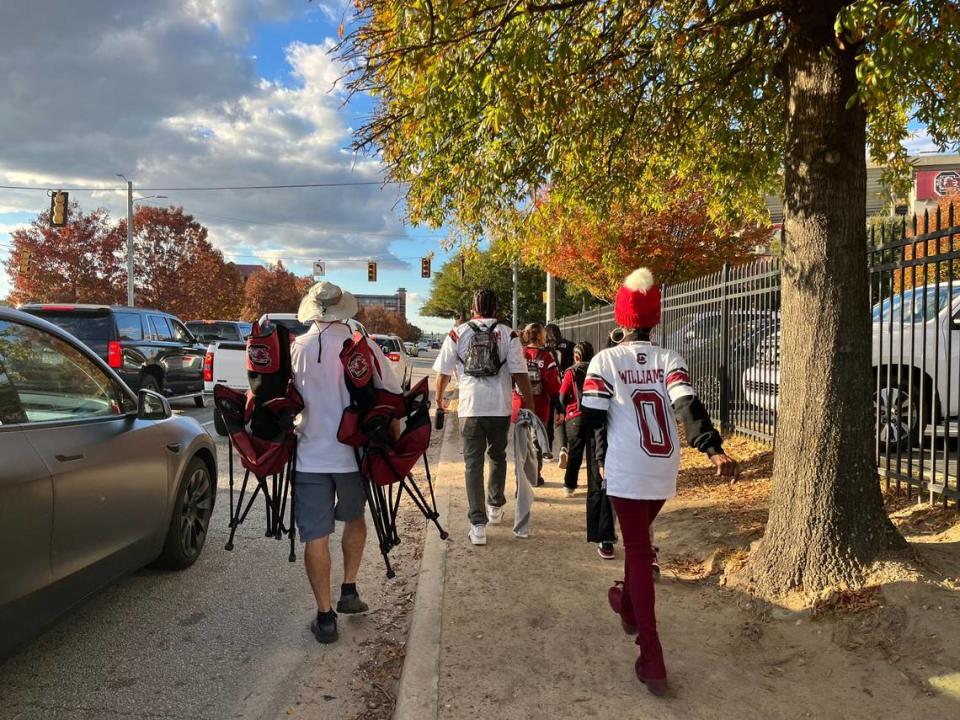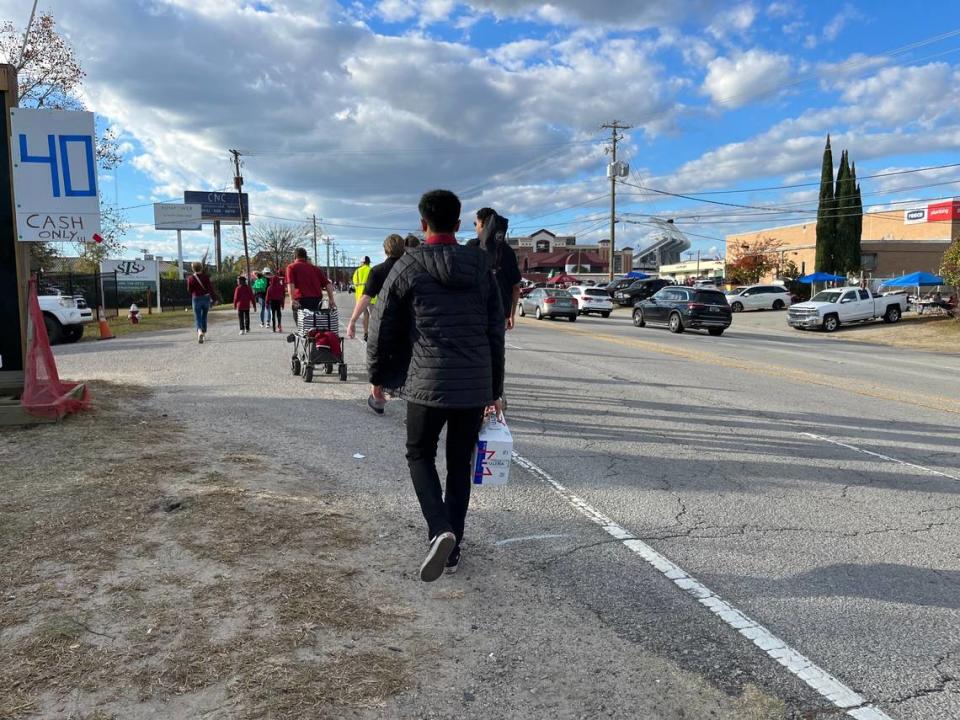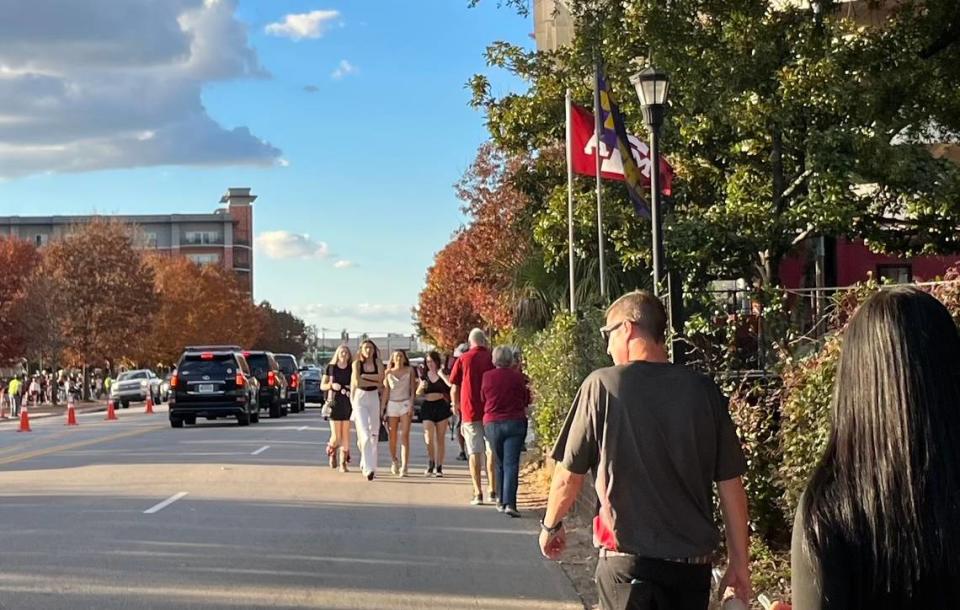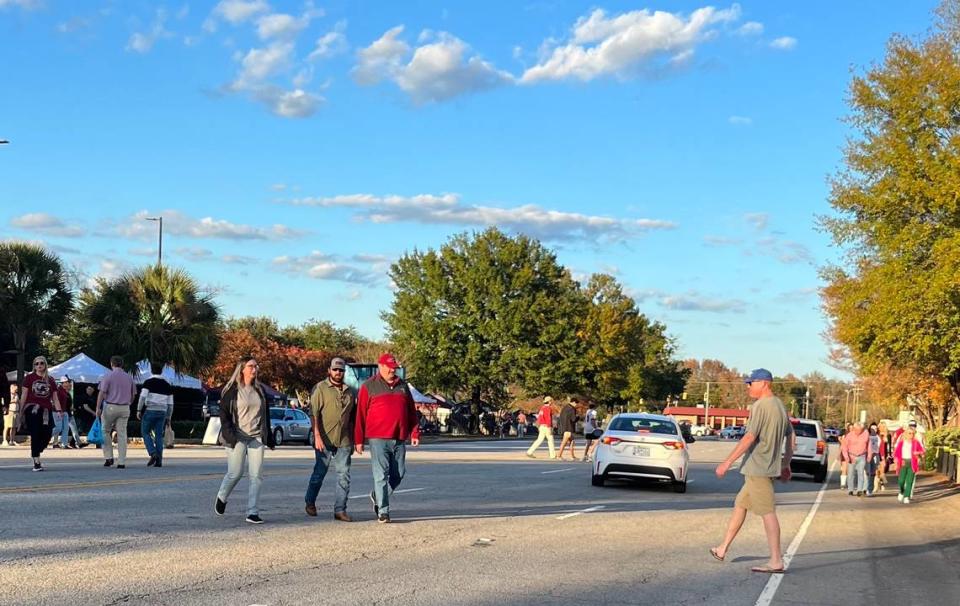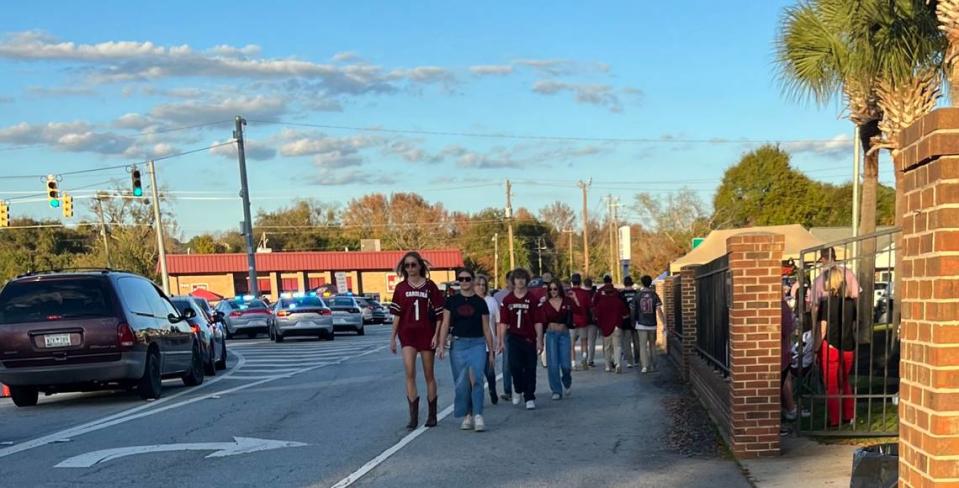‘Just embarrassing’: Sidewalks scarce near USC’s Williams-Brice Stadium. What’s being done?
On USC game days, Kylin Doster sells hot dogs to fans out of the trunk of his car on Bluff Road — $7 will get you two dogs with all the fixings.
He’s a quiet spectator of game day chaos, and he often worries for the safety of his customers. College students dart into the four-lane roads around the stadium, he said, and though pedestrians have the right of way, cars don’t stop — they won’t even slow down.
There’s one thing he said he knows for certain.
“We need more sidewalks,” he said.
For about seven Saturdays each fall, 80,000 or so fans descend on Williams-Brice Stadium to cheer on the Gamecocks. Driving to the stadium can be frustrating as traffic often backs up for several miles. But walking from parking lots to the stadium or to tailgate can be life-threatening as fans — many of them already tipsy from partying — walk along the shoulders of four- or six-lane roads with only a few feet of grass separating parked cars and the roadway.
“It’s just embarrassing,” state Rep. Seth Rose, D-Richland, said in a recent interview with The State. “You go to a game and people are walking in the street. We don’t have sidewalks around the state fairgrounds. … I live here, I have children here, and there are things that just bother me.”
Rose recently asked a state agency to take a look at the problem, and a handful of county transportation-tax funded projects are also on the books. Will it be enough to fix the perennial pedestrian headache in southwest Columbia?
Where are the sidewalks?
Hours before kickoff, fans haul folding chairs, coolers full of drinks and wagons full of toddlers on Rosewood Drive and Bluff and Shop roads. Often, pedestrians are mere inches from moving cars, SUVs and trucks.
The corridor surrounding Williams-Brice has very few sidewalks. The majority of Shop, Bluff and Key roads have no real pedestrian walkways, and George Rogers Boulevard and the southern part of Rosewood Drive don’t either.
Most of the stretches of concrete abruptly end in places, like by the Waffle House on Bluff Road next to the stadium, and near the entrance to the state fairgrounds. The unpaved terrain along George Rogers Boulevard, and on Shop Road near The Row apartment complex, is so well-traveled, that a dusty path lies where grass might grow.
Other popular routes to the stadium, through the Olympia neighborhood or down Assembly Street, are largely without sidewalks, too.
To be fair, there are sidewalks lining the state fairgrounds on Bluff Road and wrapping around the direct perimeter of the stadium. A few blocks can be found across from the neighboring Bojangles, another few blocks near J’s Corner.
Still, much of the area goes without.
“A lot of the sidewalks are super janky directly surrounding the stadium,” said USC student Jenna Haver, who said it contrasts with the well-kept grounds of Williams Brice. “Traffic would be way better if they made the walk to the stadium easier. ... More students would walk.”
For University of South Carolina students, a typical game day means sampling tailgates, Haver said, but there are few, if any, convenient routes. Though state troopers attempt to corral both vehicles and pedestrians, sometimes there just isn’t “anywhere for people to go.”
Haver has a lot of complaints about sidewalks in Columbia and said she’s observed the ways in which they end randomly and do not connect the most densely populated areas of the city together, which has made it inaccessible without a car.
Others don’t have a strong opinion either way and shrugged off the idea of sidewalks. When traffic is at a standstill, cars are moving too slow to worry, one man said.
“It’s up to the university,” another woman opined, as she strutted down Rosewood Drive. But her companion said that more sidewalks would “just make sense.”
An introduction to the city
Standing before fresh asphalt and new sidewalks, then-Columbia Mayor Steve Benjamin praised the city’s burgeoning stadium district.
“This place is becoming very special … we’re making it special not just to folks who may come to a game or a fair, but for people who may come to visit us throughout the course of the year,” he told reporters at the 2017 press event held to announce the completion of roadwork on the portion of Bluff Road that runs alongside Williams-Brice Stadium and the state fairgrounds.
When voters approved the Richland County transportation penny sales tax in 2012, fixing this stretch of Bluff Road was one of the projects they okayed.
It included widening the road between Rosewood Drive and George Rogers Boulevard to five lanes and adding a multi-use bicycle and pedestrian path. The work cost $9.7 million, according to county documents. Not everyone thinks it made enough of an impact.
Rose recently asked the state’s Department of Transportation to work up an estimate on what it would cost to make a handful of pedestrian improvements in the district. Rose doesn’t have specifics about what improvements, if any, would be on the table just yet.
SCDOT spokesperson Kelly Moore confirmed that the department was looking into Rose’s request, noting “as with any inquiry we receive about improving roadway safety, we are going to review the request and explore possible opportunities for enhancements.” But she couldn’t provide any details about what that work could look like.
Rose feels confident that he will be able to help get state money involved in the corridor, citing recent success getting money for Five Points and Devine Street road work.
Rose said he’s been advocating for a number of pedestrian-focused DOT projects around Columbia, but one of the biggest challenges outside of money is finding contractors.
There’s so much construction happening in the Midlands, including the Carolina Crossroads project to reform Malfunction Junction, that contractors can charge a heavy premium, he said.
Right now, adding sidewalks near the stadium isn’t a priority for the university. USC spokesman Jeff Stensland said that the area around the stadium is not heavily trafficked by pedestrians, “save a handful of home games each year.”
“In those instances, pedestrians utilize the shoulders,” Stensland said. “Currently, the university encourages students to utilize shuttles and rideshares for game days.”
Haver, who lives near campus, said Ubers are “outrageously expensive.” And because of traffic, a rideshare can sometimes take just as long as walking 45 minutes or more to campus. She frequents the university-provided shuttle but said many students end up getting stuck walking along busy post-game roads.
Nearly 80,000 people cram into Williams-Brice stadium for most home games. And some 400,000 people are estimated to brave the busy corridor each year during the 12-day S.C. State Fair, which typically coincides with a Gamecock home football game.
Traffic is so heavy for Gamecocks home games that roughly 90 South Carolina state troopers are stationed at every game to control traffic in and out of the stadium. For a noon game, troopers may start showing up to the stadium around 6 a.m. to prepare, State Trooper William Bennett said.
Traffic is also rerouted before and after games. A section of Bluff Road becomes one-way immediately following a game, for example.
“Obviously, we can’t control what everybody does; if they try to cross the street on their own, we try to stop that from happening,” Bennett said.
Troopers stand at various points of the roads around the station to serve as crossing guards, Bennett explained. Their biggest concern is people walking into the road at undesignated points. Crosswalks are few and far between the farther you get from Williams-Brice. Groups of USC fans can be seen weaving through stopped cars; some defiantly walk elbow-to-elbow taking up an entire lane. Others opt to walk along the train tracks adjacent to George Rogers Boulevard.
More work to do, other priorities
With a long laundry list of unfinished and pending road projects around the city, Columbia City Councilman Will Brennan said he doesn’t see the stadium corridor as a first priority.
“There’s so much we have to catch up on,” he said, such as better connecting Main Street with the Vista.
He did acknowledge that the stadium area hasn’t kept pace with traffic.
“The infrastructure that’s built out there never kept in mind that there would be 80-90,000 people descending on the stadium at a time,” he said. “You almost take your life into your hands if you’re walking to a game outside of (Gamecock) Park next to the Cockabooses.”
The Park is directly across Bluff Road from the stadium, whose parking lot features the famous Cockaboose tailgating railcars.
Traffic has gradually picked up near the stadium. The stretch of Shop Road closest to George Rogers Boulevard hit a new traffic high in 2022, with an annual average daily traffic count of 12,600. At the intersection of Rosewood Drive and George Rogers Boulevard, that number also hit a new high, growing past 19,000 for the first time since at least 2011 when the available SCDOT data begins.
On the busy Bluff Road, traffic didn’t break a record, but it was up from the previous year’s figure, rising from 20,300 in 2021 to 21,200 in 2022.
In recent years several pedestrian fatalities not related to college game days have been reported in the area. In October 2022, a 25-year-old Florence man was hit by a vehicle and killed while walking at night on Bluff Road. He was about a mile from the stadium. In 2019, a man in his 70s was struck and killed in the early morning by a drunk driver while walking at the intersection of Bluff Road and George Rogers Boulevard.
Richland County still has two large transportation-tax projects to complete in the area. The next phase of the penny tax-funded Bluff Road project will see the road widened from George Rogers Boulevard to Interstate 77. Plans previously included another pedestrian walkway, but that component was removed from the project’s budget because the pedestrian traffic on that stretch of Bluff Road didn’t appear to require it, Richland County Public Works Director Michael Maloney said.
He noted the walkway could get added back into the project in the future depending on available funding, as it’s not expected to begin construction until 2025. The project’s latest estimated cost is $11.4 million.
A $46.5 million Shop Road project is also on the county’s penny tax agenda for the area. By summer 2025, the stretch of Shop Road between George Rogers Boulevard and Mauney Drive south of the stadium is expected to be five lanes, with 5-foot sidewalks on both sides, a center median and 4-foot bike lanes, according to the most recent Richland County penny tax update.
“Our main emphasis is commuters, transportation, visitors of all kinds,” Maloney said, explaining that the work isn’t just meant to address game-day traffic.
Brennan said for any truly “transformative” project, all relevant players need to be involved, including the university, the county and the state. He added that the city also hopes to see more private development shouldering the burden of building out sidewalks and other pedestrian amenities.
USC announced ambitious plans for a massive development just south of Williams-Brice in February, a potential $1 billion investment that could rival the allure of some professional sports teams — university officials have cited the Braves’ Truist Park in Atlanta as inspiration.
At the time, USC Athletics Director Ray Tanner said the university was hopeful that it would have amenities that would bring people to the area “365 days a year.”
About 900 acres between Bluff Road and the Congaree River are being eyed for the project, and in the spring, proposals rolled in. There was so much interest, the university extended an initial deadline and received dozens of responses.
While the university has not yet shared its plans, some have theorized about condos, hotels and restaurants. If any are built adjacent to the stadium, pedestrian traffic could increase year-round.
Still, the university isn’t willing to look too far into the future when it comes to new pedestrian routes, though student housing has popped up in the vicinity in recent years, and some apartment complexes down Bluff Road are nearly two decades old.
“Pedestrian-friendly eggresses in the area surrounding the stadium could be a part of future development planning, but it would be premature to speculate on details,” Stensland said.
On Nov. 18, just hours before the Gamecocks played Kentucky at Williams-Brice, Doster, the hot dog vendor, turned up the music playing from a speaker in his trunk as the smell of sausages wafted up from his small steam table. He remarked on the crazy, cutthroat nature of USC game day vending.
It’s is not unlike the game day traffic, which he said makes being a pedestrian dangerous.
“We can do better.”


